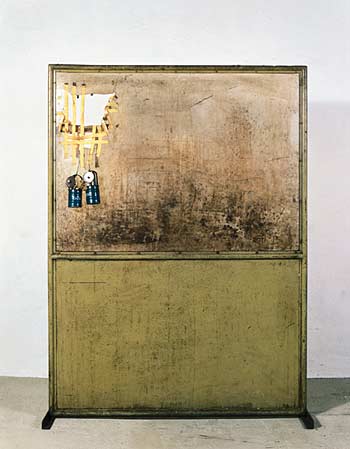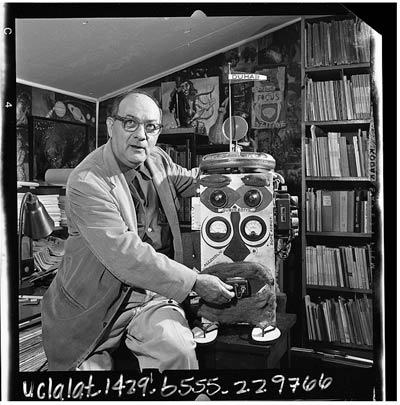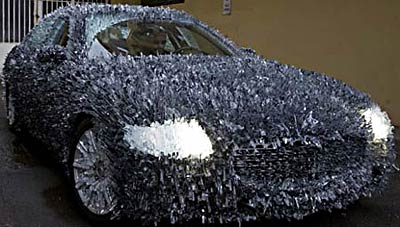technology

Last summer, the world’s top software-security experts were panicked by the discovery of a drone-like computer virus, radically different from and far more sophisticated than any they’d seen. The race was on to figure out its payload, its purpose, and who was behind it. As the world now knows, the Stuxnet worm appears to have attacked Iran’s nuclear program. And, as Michael Joseph Gross reports, while its source remains something of a mystery, Stuxnet is the new face of 21st-century warfare: invisible, anonymous, and devastating.
{ Vanity Fair | full story }
technology, uh oh | March 2nd, 2011 7:25 pm
google, video | March 2nd, 2011 6:07 pm

Piracy is the Future of Television
The convergence of television and the Internet is in its early stages, and the two media will increasingly interconnect over the coming years. A number of services are currently competing to become the dominant protocol for consumption of TV content via the Internet. This paper examines the major services that are currently available for downloading or streaming television programs online, both legal and illegal. We propose that, of the options now available to media users, illegal downloading is the most usable and feature-rich, and bears the greatest potential for pioneering new modes of audience engagement, as well as new global revenue streams, related to television products.
{ Abigail De Kosnik, University of California, Berkeley | PDF | Continue reading }
photo { William Eggleston }
future, technology, uh oh | March 1st, 2011 8:07 pm

What happens after Yahoo acquires you.
Whether it’s Flickr, Delicious, MyBlogLog, or Upcoming, the post-purchase story is a similar one. Both sides talk about all the wonderful things they will do together. Then reality sets in. They get bogged down trying to overcome integration obstacles, endless meetings, and stifling bureaucracy. The products slow down or stop moving forward entirely. Once they hit the two-year mark and are free to leave, the founders take off.
{ 37signals | Continue reading }
economics, technology | February 28th, 2011 6:00 pm

In October 2009 John Walkenbach noticed that the price of the Kindle was falling at a consistent rate, lowering almost on a schedule. By June 2010, the rate was so unwavering that he could easily forecast the date at which the Kindle would be free: November 2011.
In August, 2010 I had the chance to point it out to Jeff Bezos, CEO of Amazon. He merely smiled and said, “Oh, you noticed that!” And then smiled again. When I brought it to the attention of publishing veterans they would often laugh nervously. How outrageous! they would say. It must cost something to make? The trick was figuring out how Amazon could bundle the free Kindle and still make money. My thought was the cell phone model: a free Kindle if you buy X number of e-books.
But last week Michael Arrington at TechCruch reported on a rumor which hints at a more clever plan: a free Kindle for every Prime customer of Amazon. Prime customers pay $79 per year for free 2-day shipping, and as of last week, free unlimited streaming movies (a la Netflix). Arrington writes:
In January Amazon offered select customers a free Kindle of sorts – they had to pay for it, but if they didn’t like it they could get a full refund and keep the device. It turns out that was just a test run for a much more ambitious program. A reliable source tells us Amazon wants to give a free Kindle to every Amazon Prime subscriber.
{ The Technium | Continue reading }
artwork { Marc Newson, Voronoi Shelf, 2006 | white Carrara marble }
related { Netflix Adds Subtitles to More Streaming Content, Stirs Up Controversy. }
economics, technology | February 28th, 2011 5:50 pm

There is no precise distinction between analog and digital computing, but, in general, digital computing deals with integers, binary sequences, and time that is idealized into discrete increments, while analog computing deals with real numbers and continuous variables, including time as it appears to exist in the real world. The past sixty years have brought such advances in digital computing that it may seem anachronistic to view analog computing as an important scientific concept, but, more than ever, it is.
{ George Dyson/Edge | Continue reading }
thing { Joseph Beuys, Gefängnis (Kabir + Daktyl), 1983 }
ideas, technology | February 28th, 2011 12:40 pm

Google just changed its search algorithm and effectively declared war on Content Farms like Demand Media.
In a blog post, Google search engineers Amit Singhal and Matt Cutts write that the update, which will effect a whopping 11.8% of all search results, “is designed to reduce rankings for low-quality sites—sites which are low-value add for users, copy content from other websites or sites that are just not very useful.”
{ Business Insider | Continue reading }
painting { Nouar }
google, technology | February 25th, 2011 12:28 pm
google, new york, photogs | February 18th, 2011 11:20 am

It’s hard to imagine some of Vincent van Gogh’s signature works without the vibrant strokes of yellow that brightened the sky in “Starry Night” and drenched his sunflowers in color. But the yellow hues in some of his paintings have mysteriously turned to brown — and now a team of European scientists has figured out why.
Using sophisticated X-ray machines, they discovered the chemical reaction to blame — one never before observed in paint. Ironically, Van Gogh’s decision to use a lighter shade of yellow paint mixed with white is responsible for the unintended darkening, according to a study published online Monday in the journal Analytical Chemistry.
“This is the kind of research that will allow art history to be rewritten,” because the colors we observe today are not necessarily the colors the artist intended, said Francesca Casadio, a cultural heritage scientist at the Art Institute of Chicago who was not involved in the work.
In a number of Van Gogh’s paintings, the yellow has dulled to coffee brown — and in about 10 cases, the discoloration is serious, said Koen Janssens, an analytical chemist at Antwerp University in Belgium who co-wrote the study.
{ LA Times | Continue reading }
drawing { Van Gogh, Sorrow, 1882 }
art, beaux-arts, colors, technology | February 15th, 2011 8:59 pm

{ Computer’s depiction of the “average” female face by country. | Daily Mail | More: Mike Mike, The Face of Tomorrow }
science, technology | February 15th, 2011 8:25 pm

Pretend for a moment that you are Google’s search engine.
Someone types the word “dresses” and hits enter. What will be the very first result? There are, of course, a lot of possibilities. Macy’s comes to mind. Maybe a specialty chain, like J. Crew or the Gap. Perhaps a Wikipedia entry on the history of hemlines.
O.K., how about the word “bedding”? Bed Bath & Beyond seems a candidate. Or Wal-Mart, or perhaps the bedding section of Amazon.com.
“Area rugs”? Crate & Barrel is a possibility. Home Depot, too, and Sears, Pier 1 or any of those Web sites with “area rug” in the name, like arearugs.com.
You could imagine a dozen contenders for each of these searches. But in the last several months, one name turned up, with uncanny regularity, in the No. 1 spot for each and every term:
J. C. Penney.
The company bested millions of sites — and not just in searches for dresses, bedding and area rugs. For months, it was consistently at or near the top in searches for “skinny jeans,” “home decor,” “comforter sets,” “furniture” and dozens of other words and phrases, from the blandly generic (“tablecloths”) to the strangely specific (“grommet top curtains”).
The New York Times asked an expert in online search, Doug Pierce of Blue Fountain Media in New York, to study this question, as well as Penney’s astoundingly strong search-term performance in recent months. What he found suggests that the digital age’s most mundane act, the Google search, often represents layer upon layer of intrigue. And the intrigue starts in the sprawling, subterranean world of “black hat” optimization, the dark art of raising the profile of a Web site with methods that Google considers tantamount to cheating.
{ NY Times | Continue reading }
painting { Franzikus Wendels, In freier Wildbahn 2, 2007/08 }
economics, google, technology | February 14th, 2011 5:52 pm

Computers are getting faster. Everybody knows that. Also, computers are getting faster faster — that is, the rate at which they’re getting faster is increasing.
True? True.
So if computers are getting so much faster, so incredibly fast, there might conceivably come a moment when they are capable of something comparable to human intelligence. Artificial intelligence. All that horsepower could be put in the service of emulating whatever it is our brains are doing when they create consciousness — not just doing arithmetic very quickly or composing piano music but also driving cars, writing books, making ethical decisions, appreciating fancy paintings, making witty observations at cocktail parties.
If you can swallow that idea, and Kurzweil and a lot of other very smart people can, then all bets are off. From that point on, there’s no reason to think computers would stop getting more powerful. They would keep on developing until they were far more intelligent than we are. Their rate of development would also continue to increase, because they would take over their own development from their slower-thinking human creator. (…)
We will successfully reverse-engineer the human brain by the mid-2020s. By the end of that decade, computers will be capable of human-level intelligence. Kurzweil puts the date of the Singularity at 2045. In that year, he estimates, given the vast increases in computing power and the vast reductions in the cost of same, the quantity of artificial intelligence created will be about a billion times the sum of all the human intelligence that exists today.
{ Time | Continue reading }
controversy, future, technology | February 10th, 2011 6:15 pm

On May 11, 1997, chess grandmaster Garry Kasparov resigns after 19 moves in a game against Deep Blue, a chess-playing computer developed by scientists at IBM. This was the sixth and final game of their match, which Kasparov lost two games to one, with three draws.
Kasparov, a chess prodigy from Azerbaijan, was a skillful chess player from childhood. At 21, Kasparov played Anatoly Karpov for the world title, but the 49-game match ended indecisively. The next year, Kasparov beat Karpov to become the youngest world champion in history. With a FIDE (Federation International des Echecs) score of 2800, and a streak of 12 world chess titles in a row, Kasparov was considered the greatest chess player in history going into his match with Deep Blue. (…)
Kasparov first played Deep Blue in 1996. The grandmaster was known for his unpredictable play, and he was able to defeat the computer by switching strategies mid-game. In 1997, Kasparov abandoned his swashbuckling style, taking more of a wait-and-see approach; this played in the computer’s favor and is commonly pointed to as the reason for his defeat.
{ History | Continue reading | IBM archive of Kasparov vs Deep Blue }
chess, flashback, technology | February 10th, 2011 5:00 pm

Each year for the past two decades, the artificial-intelligence community has convened for the field’s most anticipated and controversial event—a meeting to confer the Loebner Prize on the winner of a competition called the Turing Test. The test is named for the British mathematician Alan Turing, one of the founders of computer science, who in 1950 attempted to answer one of the field’s earliest questions: can machines think? That is, would it ever be possible to construct a computer so sophisticated that it could actually be said to be thinking, to be intelligent, to have a mind? And if indeed there were, someday, such a machine: how would we know?
Instead of debating this question on purely theoretical grounds, Turing proposed an experiment. Several judges each pose questions, via computer terminal, to several pairs of unseen correspondents, one a human “confederate,” the other a computer program, and attempt to discern which is which. The dialogue can range from small talk to trivia questions, from celebrity gossip to heavy-duty philosophy—the whole gamut of human conversation. Turing predicted that by the year 2000, computers would be able to fool 30 percent of human judges after five minutes of conversation, and that as a result, one would “be able to speak of machines thinking without expecting to be contradicted.”
Turing’s prediction has not come to pass; however, at the 2008 contest, the top-scoring computer program missed that mark by just a single vote.
{ The Atlantic | Continue reading }
related { Developed over four years at an estimated cost of more than $30 million, IBM’s “Jeopardy”-playing computer, Watson, will face the quiz show’s grand masters, Ken Jennings and Brad Rutter, in two games to be aired Feb. 14, 15 and 16. Doubts remain about how well Watson can process the endless subtleties of human language. WSJ | full story }
photo { Brian Ulrich }
robots & ai, technology | February 8th, 2011 8:29 pm

I have only met Arianna Huffington once. I remember it vividly but my guess is she doesn’t remember it much at all, which says volumes about both of us. The scene was surreal. Huffington and I were in Larry Flynt’s office in Los Angeles, participating in an experimental online talk show Larry was trying to distribute over the Internet. Our topic for the moment was gun control: I was conflicted while Huffington was violently opposed to guns, citing their danger to children, which she thought should over-rule any constitutional argument. I made a point and she replied with the motherhood card, “Well you obviously have never had children.” Point and match for Huffington. Game over.
But I had children. Back then I was the father of two sons, one of whom had died in my arms only a few months before. That memory was still too vivid for me to even respond to Huffington, who took my silence as capitulation, and maybe it was. She easily threw her kids into the battle while I couldn’t do the same with mine.
Maybe she sensed my weakness.
That was long before the Huffington Post was even thought of, but it was the first thing that came to mind when I read this week that AOL was buying the blog for $315 million. What AOL is buying, primarily, is Arianna Huffington in her role as media baron (baroness?) in the Fleet Street tradition, and it is a perfect fit. Huffington is at heart a female Rupert Murdoch, she just came to it too late in life. Like Murdoch she is all about taking a position and relentlessly pushing it to attract like-minded readers and advertisers. The story is everything. Well that and the money.
Did I mention that, inspired by Huffington, this blog, too, is for sale? By her metrics it’s worth $20 million, but I’d take a tenth of that.
{ Robert X. Cringely | Continue reading }
related { Barry Ritholtz | AOL-Huffington Post: Why the Heavy Breathing? }
economics, experience, technology | February 8th, 2011 8:20 pm

The problem is that glass breaks before it bends – even the tiniest fracture spreads rapidly in all directions until the entire pane shatters. In engineering terms, glass is strong (it can withstand a lot of stress before cracking) but not tough (it has little damage tolerance after the onset of cracking). This is in contrast to sheets of metal or plastic that can deform to accommodate small defects, making them generally tougher materials.
To a group of researchers at Lawrence Berkeley National Laboratory and Caltech, this begged the question: is it possible to engineer tougher glass by making it behave more like metal? The answer, it turns out, is yes.
{ Berkeley Science Review | Continue reading }
photo { Maserati Quattroporte covered with 1,763 lbs of shattered glass by Luca Pancrazzi }
science, technology | February 8th, 2011 8:15 pm

{ A lamp shade robot, an Auger-Loizeau Carnivorous Domestic Robot Entertainment design, is powered by incoming flies.| Meat-eating furniture | NPR | full story }
technology, visual design | February 8th, 2011 7:40 pm

A giant net several kilometres in size has been built as part of a collaboration between Japan’s space agency and a 100-year-old fishing net company to collect debris from space.
Last year, a US report concluded that space was so littered with debris that a collision between satellites could set off an “uncontrolled chain reaction” capable of destroying the communications network on Earth. It is estimated there are 370,000 pieces of space junk.
The Japanese plan will see a satellite attached to a thin metal net spanning several kilometres launched into space. The net is then detached, and begins to orbit earth, sweeping up space waste in its path.
During its rubbish collecting journey, the net will become charged with electricity and eventually be drawn back towards earth by magnetic fields – before both the net and its contents burn upon entering the atmosphere.
{ Telegraph | Continue reading }
space, technology | February 7th, 2011 8:19 pm

The authors analyze a multimillion dollar, three-year field study sponsored by five firms to assess whether enabling skipping of advertisements using digital video recorders (DVRs) affects consumers’ shopping behavior for advertised and private label goods. (…)
The predicted DVR effect is tightly centered around 0, suggesting that the data have sufficient power to identify a true null effect.
{ American Marketing Association | Continue reading }
marketing, technology | February 5th, 2011 8:25 pm

This article examines peer-to-peer (P2P) file sharing and the copyright enforcement problem it has created through the lens of scalability. Writing about the growth and governance of the Internet, David Post observed that “scaling problems - the problems that arise solely as a consequence of increasing size or increasing numbers - can be profound, and profoundly difficult to solve.” Both the Internet’s designers and P2P network designers solved difficult problems of scale in their efforts to revolutionize the distribution of information goods. In doing so, however, they created a problem of scale in the form of “massive infringement.” How to approach solving that problem of scale is the subject of this article.
{ SSRN | Continue reading | PDF }
law, technology | February 2nd, 2011 3:40 pm






















